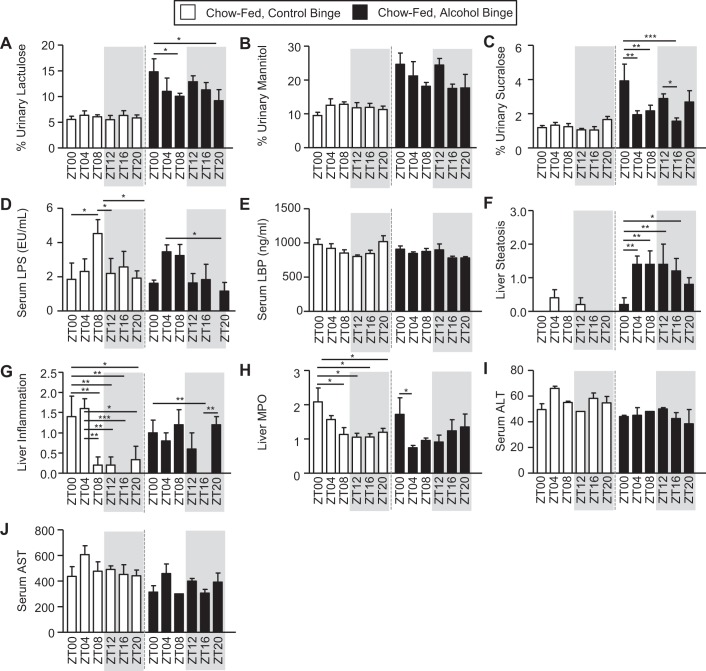Fig. 3.
Binge- and time-dependent effects on markers of intestinal barrier integrity and liver inflammation in chow-fed mice. Mice were fed a chow diet for 4 wk, and during the 5th wk (i.e., days 43–45), mice were administered a once/daily binge of alcohol (6 g/kg) or the vehicle control for alcohol (i.e., PBS) at a specific time indicated by the zeitgeber time (ZT). After the first binge, mice were immediately returned to the home cage; then they were given a test for intestinal permeability immediately following the 2nd binge, and then they were euthanized 4 h after the 3rd and final once/daily binge. Intestinal barrier integrity and liver pathology were assessed. A–C: intestinal barrier integrity was evaluated following the bolus administration of a sugar solution, and urinary sugar was measured as an index of barrier integrity; higher urinary sugar equates to greater barrier dysfunction. A: urinary lactulose exhibited a significant effect of binge (P < 0.00) but no effect of diet nor an interaction. Post hoc Tukey’s test revealed significant time-of-day effects. B: urinary mannitol exhibited a significant effect of binge (P < 0.00) but no effect of diet or an interaction. Post hoc Tukey’s test revealed no significant effects. C: urinary sucralose revealed a significant effect of binge (P < 0.00) and time (P = 0.04) but no interaction. Post hoc Tukey’s test revealed significant time-of-day effects. D and E: intestinal barrier integrity was also evaluated using serum markers, including lipopolysaccharide (LPS) and LPS-binding protein (LBP). D: serum LPS exhibited a significant effect of time (P = 0.01) but no effect of binge or an interaction. Post hoc Tukey’s test revealed significant time-of-day effects. E: serum LBP levels were not affected by binge or time, nor was there an interaction. F–J: next, we assessed liver pathology using a combination of histological and serum analysis approaches. F: liver steatosis exhibited a significant effect of binge (Kruskal-Wallis, P < 0.00) but no effect of time. Post hoc Tukey’s test revealed significant time-of-day effects. G: liver inflammation exhibited a significant effect of time (Kruskal-Wallis, P < 0.00) but no effect of binge or an interaction. Post hoc Tukey’s test revealed significant time of day effects. H: liver myeloperoxidase (MPO) exhibited a significant main effect of time (P = 0.01) but no effect of binge or an interaction. Post hoc Tukey’s test revealed significant time-of-day effects. I: serum alanine aminotransferase (ALT) exhibited a significant effect of binge (P = 0.03) but not time, nor was there an interaction. Post hoc Tukey’s test revealed no significant effects. J: serum aspartate aminotransferase (AST) exhibited a significant effect of binge (P < 0.00) but no effect of time or an interaction. Post hoc Tukey’s test revealed no significant differences. Between n = 5 and 10 mice were included in each treatment group at each time point. Two-way ANOVA, followed by post hoc Tukey’s test (*P < 0.05; **P < 0.01; ***P < 0.001), was used for analysis unless noted. ZT, zeitgeber time (binge time).

